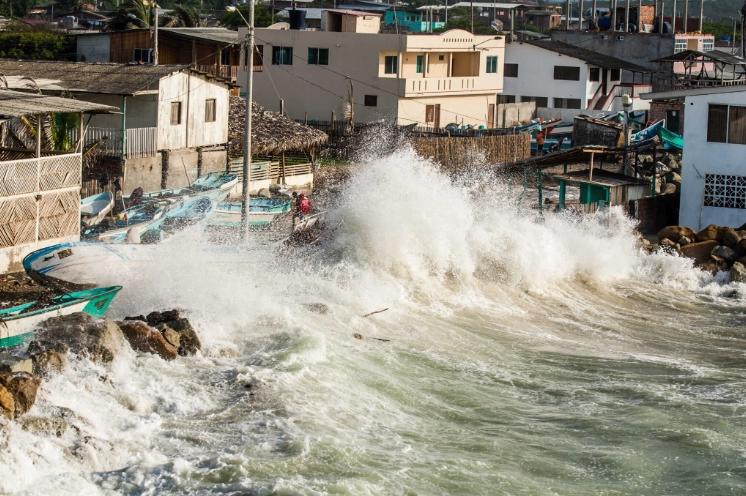In the face of an impending natural disaster such as a hurricane, flood, or tsunami, an alert just 24 hours in advance can reduce damage by 30%. Compared to countries with early warning systems, countries with low coverage have eight times higher mortality because people and authorities cannot make informed decisions in advance. Experience has shown that early warning systems are a reliable — as well as cost-effective — solution to protect people’s lives and livelihoods from natural disasters.
What is an Early Warning System and why is it important?
According to the United Nations (UN), an Early Warning System (EWS) combines hazard monitoring, forecasting, and prediction with disaster risk assessment, communication, and preparedness activities. An EWS enables individuals, communities, governments, and businesses to take preventive action to reduce the risk of catastrophes before dangerous events occur.
The planet is warming at a faster rate than at any time in history, which is causing disasters to become more severe and more frequent. So these systems are becoming increasingly essential. In this context, in March 2022, UN Secretary-General António Guterres launched the global Early Warning for All (EW4All) initiative, which aims to have the whole world protected by early warning systems by the end of 2027.
The implementation of Multi-Hazard Early Warning Systems (MHEWS) can save lives while preventing and minimizing losses and damages. These systems provide a ten-fold return on investment and, according to UN agency reports, countries with low MHEWS coverage have five times more people affected by disasters than countries with high coverage.
To put figures on the matter, according to estimates by the UN Global Commission on Adaptation, an investment of US$ 800 million in the installation of early warning systems in developing countries could prevent annual losses of between US$ 3 and 16 billion. Since three out of every four people on the planet have a cell phone, and most have access to broadband networks, communication of warnings is guaranteed.
Early warning systems are made up of different interlinked components, where, once the alarm has been issued, there is a public body in charge of giving evacuation instructions and providing facilities such as food and shelter to those impacted. Therefore, after the warning is received by the people, the following stages are activated depending on the level of the catastrophe and the person affected. In addition, these systems also have a governance system dedicated to the reconstruction of infrastructure for the post-disaster stages.
The development and implementation of local disaster risk reduction strategies have increased since the adoption by UN member countries of the Sendai Framework for Disaster Risk Reduction, which established in 2015 seven global targets to reduce disaster risks and disaster losses. However, so far, only half of the world (52%) is covered by an early warning system, according to the 2023 Global Status of Multi-Hazard Early Warning Systems, presented during COP28 in Dubai. Although only 101 countries have advanced warning systems, the number has doubled since 2015, when only 46% of the least developed countries and 39% of Small Island Developing States had such warning systems in place.
What makes an Early Warning System effective?
An effective warning system must detect different threats that may occur independently, simultaneously, or in cascade. In addition, it must cover from hazard detection to early action, which includes providing understandable and actionable warning messages. And finally, it must be people-centric so they can act in a timely and appropriate manner to reduce potential harm.
Therefore, warning services must have more and better data from meteorological, climatic, and hydrological services. In the case of health, adapted climate information and services are needed in the face of increasing extreme weather events, poor air quality, changing patterns of infectious diseases, and food and water insecurity. Nearly three-quarters of National Meteorological and Hydrological Services (NMHSs) provide climate data to the health sector, but their use is limited. Less than a quarter of Ministries of Health globally have a health surveillance system that uses weather information to monitor climate-sensitive health risks.
Still, a recent study has shown that simply improving the accuracy of weather forecasts will not translate into better outcomes for vulnerable people. Most of the deadliest and costliest hydrometeorological disasters of this century have been predicted in advance. Yet, the biggest gaps, and where there were opportunities for improvement, were found to lie in communication and response capability. Consequently, the design and implementation of any MHEWS must take an integrated, people-centered approach.
Within this framework, during the implementation phase of the global Early Warning for All initiative promoted by the UN, the focus has been on 30 of the most vulnerable countries globally and on complementary activities to be developed in other nations. In the case of Latin America and the Caribbean, six of the most at-risk countries have been selected: Antigua and Barbuda, Barbados, Ecuador, Guatemala, Guyana, and Haiti.
Last year, extreme weather and climate events had a significant impact on all continents, with major floods and rising rivers, tropical cyclones, extreme heat and drought, and resulting wildfires. The wildfire season in Canada far exceeded all previous seasons and caused severe smoke pollution episodes, especially in densely populated areas, and the most lethal fire of the year occurred in Hawaii, where at least 99 fatalities were reported.
2023 was the warmest year on record, and the warming effect of the current El Niño episode is likely to further intensify the heat in 2024. This will cause even more extreme weather events that will destroy more lives and livelihoods. Therefore, we must ensure and work to ensure that all countries have Multi-Hazard Early Warning Systems that allow informed and timely decisions to be made to mitigate adverse effects. EWS are not a luxury, but a cost-effective tool that saves lives and reduces economic losses.
*Translated by Janaína Ruviaro da Silva from the original in Spanish












